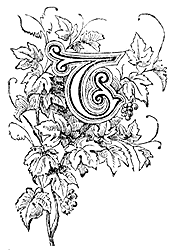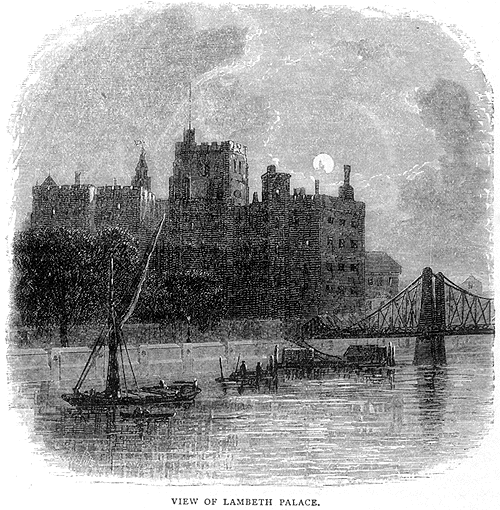
The prior and canons, however, appealed to the Pope, who took a just view of the affair, and obliged the furious archbishop to atone for his cruelty by building a palace at Lambeth, as we have already said, in place of the old and smaller one. The building is varied in style from early English to the late perpendicular. The gatehouse entrance built by Cardinal Morton, in 1490, has an enriched centre, two large square towers of red brick, with stone dressing, and a spacious Tudor archway. The towers are gained by a spiral staircase that leads to the Record-room, which contains many of the Archives of the See. The chapel dates from 1244, and is early English with lancet windows. Its beautiful painted glass windows were destroyed in the civil wars, but Archbishop Tait, in 1868-82, put up new ones, and had the chapel decorated in fresco. The oak screen was presented by Laud, and bears his arms. Archbishop Parker, to whom Anne Boleyn entrusted her little daughter Elizabeth, lies before the altar. But the most interesting portion of Lambeth is the Lollards' Tower. It was built by Archbishop Chicheley in 1434 and 1435. It is a large stone building, and contains the prison in which the Lollards were immured; the ascent to it is by a narrow newel staircase, the steps of which are much worn by the many reluctant feet that formerly ascended them. It is entered by a small, pointed stone doorway, so narrow that one person at a time only can pass it. There is a double door to it of strong oak thickly studded with iron, and with strong iron fastenings. The walls are lined with very thick oak wainscotting, which also covers the ceiling. Fastened into the wainscot, which is an inch and a half thick, are eight large iron rings. It has two very small windows, narrowing outwards. There is a small chimney. On the wainscot are scratches - a few words here and there - a cross cut with a knife by the prisoners of those unhappy days. The Lollards were thus named from their custom of singing hymns at funerals (from the German lollen) They were a sect whose preaching caused a great change in the religious opinions of the day; but they were fanatical and unsocial in their habits, and certainly greatly resembled the Puritans of a following age. They were mostly adherents of Wickliffe, who was himself brought before a private council at Lambeth, to answer for his opinions. He had previously been cited to St. Paul's, and was there defended by the famous John of Gaunt; now he was without the support of the great Lancaster's presence. But he had even more powerful protection in the citizens of London, who (with a mob of the people) forced themselves into the chapel to speak in favour of Wickliffe, while the queen's mother sent Sir Lewis Clifford to forbid them to pronounce any definitive sentence against him. Good Queen Anne, Richard lI.'s adored queen, protected the followers of Wickliffe while she lived, and herself read the Scriptures in his translation. The Church of England was for this first and only time in her history disloyal, when her archbishop and bishops joined the House of Lancaster against Richard 11. and Henry IV., to reward their personal attachment to himself, passed the law by which heretics were to be burnt alive unless they submitted to the Church, the first law of the kind ever known in England. William Sautre was the first who was burnt under this new and cruel edict, the first martyr of the Reformation, but he was put to death by Arundel, and was not one of those who were shut up in Archbishop Chicheley's Tower. We are not writing a history of martyrdom, or we might give in detail the story of one of the occupants of the Lollards' Tower, whose fate was exceptionally cruel; she was Joan Boughton, a lady, and over eighty years of age, who suffered at the stake, as did her daughter, Lady Young. We can never gaze on the Lollards' Tower without an emotion of gratitude that God has placed us in a happier and gentler age. Two Popish prelates were committed to the Archbishop's Tower by Elizabeth, who also occasionally immured state prisoners in it. These prisoners were kept in separate apartments, and had their meals at the Archbishop's table. Outside the Tower is a niche, in which was a statue of St. Thomas a Becket, and adjoining the porter's lodge there is a small room with immensely thick stone walls, a double door, high and narrow windows, and iron rings in the walls, as in the Lollards' Tower, showing that it also was a prison. There is a curious account extant of the expense of building the Tower, which, as it gives us an idea of the rate of wages at that period, may be interesting. A bricklayer's and a tiler's wages were then 4d. a day with their food; a labourer's with food was 3d., without food, 3 1/2d.; so a halfpenny was thought a sufficient sum to feed a man. The whole expense of building the Tower was only £278 2s. 11 1/2d., though the iron work in it weighed 1,322 1/2 pounds. At the great gate of the palace the Dole to the poor has been given from time immemorial. The Post room has some fine carving on the ceiling, and the library, or Juxon's hall, is a noble apartment, containing 30,000 volumes besides MSS. Many of these are very rare and valuable. The library has a fine timber roof. It is open to the public from ten till four, five days in the week, from April to July. In the palace there is an historical series of portraits of the Archbishops of Canterbury from 1570, many of them by great artists. * * * * * * |
||||

